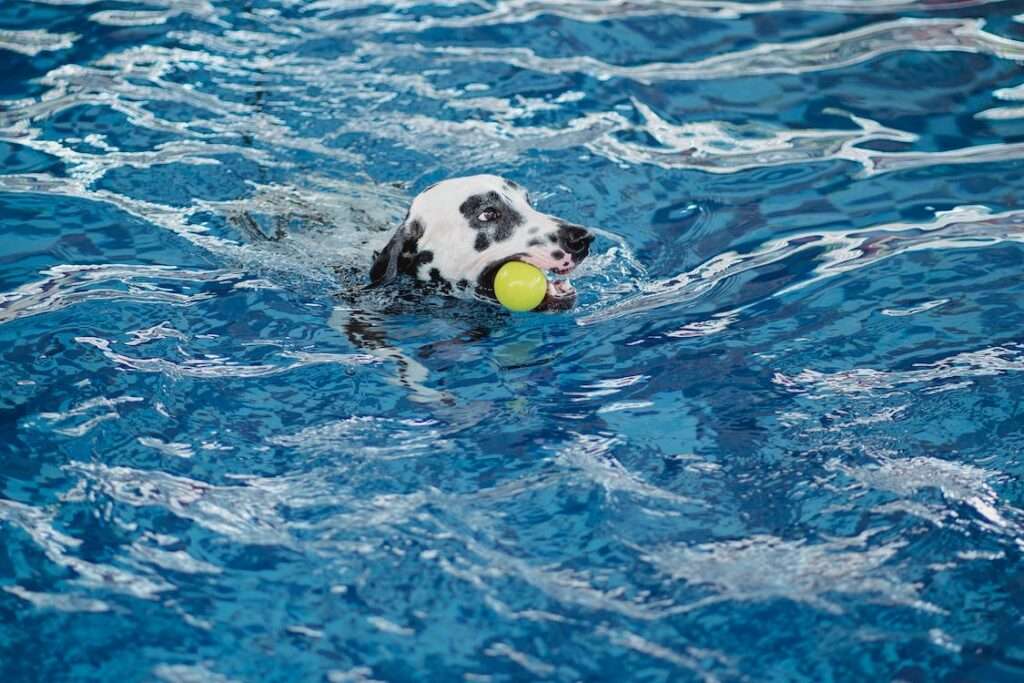Can All Dogs Swim? Discover the Truth About Your Pet’s Aquatic Abilities!
As a dog owner, you may have wondered whether all dogs can swim. It’s a valid question and one that can have significant implications for your pet’s health and safety. The history of dogs and swimming is a fascinating one, and the benefits of swimming for dogs are numerous.
In this article, we aim to delve into the topic of whether every dog is naturally equipped for swimming. Our goal is to provide you with the knowledge and insights necessary to ensure the well-being and security of your cherished companion.
Can All Dogs Swim?

“The short answer is no, not all dogs can swim.”
Some breeds are born to swim, while others struggle with this activity. Breeds that are born to swim, such as the Labrador Retriever and the Newfoundland, have physical characteristics that make them excellent swimmers. These breeds have webbed feet, a waterproof coat, and a strong tail that helps them navigate through water.
On the other hand, breeds that struggle with swimming, such as the Bulldog and the Pug, have physical characteristics that make swimming difficult for them. These breeds have short legs, a heavy body, and a flat face, which can cause breathing difficulties when in the water. Additionally, a dog’s age, weight, and any existing health conditions are all factors that can impact their ability to swim.
It’s essential to know whether your dog can swim and take appropriate precautions to keep them safe. In the next section, we will discuss how to teach your dog to swim and safety tips for swimming with your pet.
How to Teach Your Dog to Swim
If your furry companion is not a natural swimmer, it’s important to introduce them to swimming gradually and safely. By following these steps, you can help your dog become comfortable and confident in the water:
- Choose the ideal location: Select a shallow and calm area for your dog’s swimming lessons. A pool with a gradual slope or a serene lake are great options. Steer clear of locations with strong currents, deep waters, or waves that can be overwhelming for a beginner.
- Get the right equipment: Equip your dog with a well-fitted life jacket. This essential gear will keep them buoyant and give them an added sense of security. You can also entice them with a floating toy to make swimming more enjoyable.
- Gradual introduction to water: Begin by allowing your dog to dip their paws in the water, one step at a time. Give them plenty of time to explore and adjust to the sensation. Use treats and positive reinforcement to encourage their progress and let them associate swimming with a positive experience.
- Positive reinforcement: Shower your dog with praise, affection, and rewards when they make efforts to swim. Treats, toys, and words of encouragement can go a long way in boosting their confidence. Avoid any forceful or rushed approach, as it may cause anxiety or fear.
Remember, each dog learns at their own pace. Some may take to swimming like naturals, while others might need more time and patience. To ensure a safe swimming experience, keep a watchful eye on your dog at all times. Monitor their energy levels, provide regular breaks, and never leave them unsupervised in or near the water. Be their supportive guide throughout the process and celebrate their achievements, no matter how small.
Safety Tips for Swimming with Your Dog
Swimming with your beloved canine companion can create unforgettable memories, but safety should always be a top priority. Follow these essential safety tips to ensure a worry-free and enjoyable swimming experience:
- Know your dog’s limitations: Not all dogs are natural swimmers, and some may have health conditions that make swimming unsafe. Consult with your veterinarian to determine if swimming is suitable for your furry friend based on their breed, age, and overall health.
- The dangers of open water: Open water can be unpredictable, with currents that pose risks even for skilled swimmers. Keep your dog close to you and choose swimming areas that are free from strong currents, hazardous waves, or excessive boat traffic.
- Utilize a well-fitted life jacket: Invest in a high-quality, properly fitted life jacket for your dog. A well-designed life jacket provides buoyancy, increases their visibility, and ensures their safety while swimming. Ensure the life jacket fits snugly, allowing your pet to move comfortably.
- Practice proper supervision: Never leave your dog unattended while they are swimming. Keep a close eye on them at all times, watching for any signs of distress or fatigue. Be ready to provide assistance or rescue if necessary.
- Be aware of signs of distress: Dogs can tire quickly while swimming, especially if they are inexperienced or have lower stamina. Watch for signs of exhaustion, such as a drooping head, low energy, or difficulty breathing. If you observe any of these signs, remove your dog from the water immediately and provide them with a restful break.
Always tailor your swimming activities to your dog’s abilities and preferences, and never force them into the water if they show signs of discomfort or fear. With careful attention, proper supervision, and a focus on safety, swimming can become a cherished shared activity that strengthens the bond between you and your furry friend.
Benefits of Swimming for Dogs

Swimming is an excellent low-impact exercise for dogs, providing numerous benefits for their physical and mental health. Here are some of the benefits of swimming for dogs:
- Cardiovascular health: Swimming is a fantastic cardiovascular exercise that gets your dog’s heart pumping. It helps improve circulation, strengthens the heart muscles, and enhances overall cardiovascular fitness.
- Muscle tone and flexibility: The resistance of the water provides a gentle yet effective workout for your dog’s muscles. Swimming engages various muscle groups, particularly in the legs, promoting muscle tone and enhancing flexibility.
- Weight management: Swimming is an excellent option for dogs looking to shed a few pounds or maintain a healthy weight. The low-impact nature of swimming allows for calorie burning without putting excessive strain on the joints, making it an ideal exercise for overweight or obese dogs.
- Joint health: The buoyancy of water reduces the impact on your dog’s joints, making swimming an excellent choice for dogs with joint conditions like arthritis or hip dysplasia. It allows them to exercise without placing excessive stress on their joints, promoting joint mobility and potentially alleviating discomfort.
- Mental stimulation: Swimming isn’t just a physical workout; it also provides mental stimulation for your dog. Navigating through the water, chasing toys, and retrieving items engage their cognitive abilities, providing an outlet for mental stimulation and preventing boredom.
Swimming can be a fun and rewarding activity for you and your furry friend. By incorporating swimming into your dog’s exercise routine, you can provide them with a well-rounded, enjoyable, and beneficial form of physical activity that supports their overall health and happiness.
Conclusion
In conclusion, not all dogs can swim, and it’s essential to know your pet’s limitations and take appropriate safety measures when swimming with them. If you have a breed that is not a natural swimmer, it’s crucial to teach them how to swim safely and gradually.
Swimming can be a fun and beneficial activity for dogs, providing numerous physical and mental health benefits. By following the safety tips and teaching your dog how to swim, you can enjoy this activity together and improve your pet’s health and well-being.
Remember, always consult with your vet before introducing your dog to swimming, especially if they have any health conditions or are elderly. With proper training, supervision, and safety measures, you and your dog can enjoy a safe and enjoyable swim.
Frequently Asked Questions
Q: Can all dog breeds swim?
A: While many dog breeds have an instinctual ability to swim, not all dogs are natural swimmers. Some breeds are more proficient in swimming due to their physical characteristics, such as webbed feet, a water-resistant coat, or a strong build. However, individual dogs within any breed may have varying levels of comfort and skill in the water.
Q: Are there dog breeds that are not suited for swimming?
A: Yes, some dog breeds are not well-suited for swimming due to factors like their body structure, short legs, or heavy body mass. Breeds with short muzzles, such as Bulldogs or Pugs, may struggle with swimming due to their brachycephalic respiratory system. It’s important to consider your dog’s physical abilities and limitations before introducing them to water activities.
Q: How can I determine if my dog can swim?
A: It’s essential to assess your dog’s comfort and ability in the water before assuming they can swim. Start by introducing them to shallow water, like a kiddie pool or a calm lake, and observe their behavior. Some dogs may take naturally to swimming, while others may exhibit anxiety or struggle to stay afloat. It’s always a good idea to consult with a professional dog trainer or a veterinarian for guidance.
Q: Can I teach my dog to swim?
A: Yes, you can help your dog learn to swim, especially if they are initially hesitant or inexperienced. Start with gentle introductions to shallow water, using positive reinforcement techniques like treats and praise. Use a doggy life jacket or floatation device to provide added support and confidence. Gradually increase the depth of the water as your dog becomes more comfortable and gains confidence.
Q: Are there any precautions I should take when my dog is swimming?
A: Yes, there are several precautions to ensure your dog’s safety while swimming. Always supervise your dog near water, even if they are experienced swimmers. Avoid strong currents, deep waters, and unfamiliar bodies of water that may pose risks. Rinse off your dog after swimming to remove chlorine or saltwater, as it can irritate their skin. Additionally, be mindful of your dog’s energy levels to prevent exhaustion while swimming.
Q: Can swimming be beneficial for dogs?
A: Yes, swimming can provide various benefits for dogs. It is a low-impact exercise that can help improve cardiovascular health, muscle tone, and joint flexibility. Swimming can be particularly beneficial for dogs with arthritis or other mobility issues. It also provides an outlet for mental stimulation and can be a fun bonding activity between dogs and their owners.
Remember, each dog is unique, and their swimming abilities may vary. If you have specific concerns about your dog’s ability to swim or any other health-related matters, it’s always best to consult with a professional veterinarian for personalized advice.




